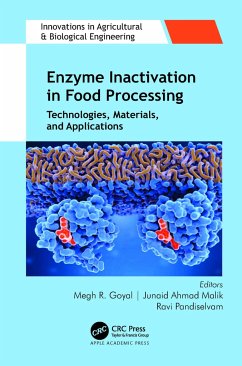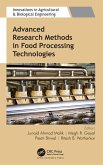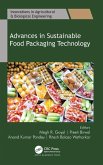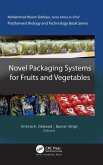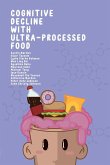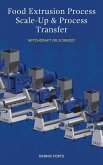Enzyme Inactivation in Food Processing
Technologies, Materials, and Applications
Herausgeber: Goyal, Megh R.; Pandiselvam, Ravi; Malik, Junaid Ahmad
Enzyme Inactivation in Food Processing
Technologies, Materials, and Applications
Herausgeber: Goyal, Megh R.; Pandiselvam, Ravi; Malik, Junaid Ahmad
- Gebundenes Buch
- Merkliste
- Auf die Merkliste
- Bewerten Bewerten
- Teilen
- Produkt teilen
- Produkterinnerung
- Produkterinnerung
Explores new technologies for the inactivation of enzymes in the design and preservation of food through advanced technologies, including nutraceutical-based functional foods, specific foods for gut-microbiodata, omega-3 fatty acids to fortify food products, characteristics of dairy-based dry powders, and more.
Andere Kunden interessierten sich auch für
![Advanced Research Methods in Food Processing Technologies Advanced Research Methods in Food Processing Technologies]() Advanced Research Methods in Food Processing Technologies221,99 €
Advanced Research Methods in Food Processing Technologies221,99 €![Advances in Sustainable Food Packaging Technology Advances in Sustainable Food Packaging Technology]() Advances in Sustainable Food Packaging Technology212,99 €
Advances in Sustainable Food Packaging Technology212,99 €![Novel Packaging Systems for Fruits and Vegetables Novel Packaging Systems for Fruits and Vegetables]() Novel Packaging Systems for Fruits and Vegetables203,99 €
Novel Packaging Systems for Fruits and Vegetables203,99 €![Cognitive Decline with Ultra-Processed Food Cognitive Decline with Ultra-Processed Food]() Austin MardonCognitive Decline with Ultra-Processed Food32,99 €
Austin MardonCognitive Decline with Ultra-Processed Food32,99 €![Food and Feed Extrusion Technology Food and Feed Extrusion Technology]() ForteFood and Feed Extrusion Technology209,99 €
ForteFood and Feed Extrusion Technology209,99 €![Enzyme Engineering Volume 2 Enzyme Engineering Volume 2]() Enzyme Engineering Volume 239,99 €
Enzyme Engineering Volume 239,99 €![Food Extrusion Process Scale-Up and Process Transfer Food Extrusion Process Scale-Up and Process Transfer]() Dennis ForteFood Extrusion Process Scale-Up and Process Transfer233,99 €
Dennis ForteFood Extrusion Process Scale-Up and Process Transfer233,99 €-
-
-
Explores new technologies for the inactivation of enzymes in the design and preservation of food through advanced technologies, including nutraceutical-based functional foods, specific foods for gut-microbiodata, omega-3 fatty acids to fortify food products, characteristics of dairy-based dry powders, and more.
Produktdetails
- Produktdetails
- Verlag: Apple Academic Press
- Seitenzahl: 570
- Erscheinungstermin: 4. August 2023
- Englisch
- Abmessung: 240mm x 161mm x 35mm
- Gewicht: 1013g
- ISBN-13: 9781774911600
- ISBN-10: 1774911604
- Artikelnr.: 68101384
- Herstellerkennzeichnung
- Libri GmbH
- Europaallee 1
- 36244 Bad Hersfeld
- gpsr@libri.de
- Verlag: Apple Academic Press
- Seitenzahl: 570
- Erscheinungstermin: 4. August 2023
- Englisch
- Abmessung: 240mm x 161mm x 35mm
- Gewicht: 1013g
- ISBN-13: 9781774911600
- ISBN-10: 1774911604
- Artikelnr.: 68101384
- Herstellerkennzeichnung
- Libri GmbH
- Europaallee 1
- 36244 Bad Hersfeld
- gpsr@libri.de
Megh R. Goyal, PhD, PE, is a prolific author and editor. He is a retired professor from the College of Engineering at the University of Puerto Rico. A former soil conservation inspector, Dr. Goyal was proclaimed as the "Father of Irrigation Engineering in Puerto Rico for the twentieth century" by the ASABE, Puerto Rico Section, for his pioneering work on micro irrigation, evapotranspiration, agroclimatology, and soil and water engineering. Junaid Ahmad Malik, PhD, is a Lecturer with the Department of Zoology at Government Degree College, Bijbehara, Kashmir (J&K), India. He has more than eight years of research experience in ecology, soil macrofauna, wildlife biology, conservation biology, etc. Dr. Malik has published more than 20 research articles and technical papers in international peer-reviewed journals and has authored and edited books, book chapters, and more than 10 popular editorial articles. He has participated in several international conferences, seminars, workshops, and symposia. He is a life member of the Society for Bioinformatics and Biological Sciences. Ravi Pandiselvam, PhD, is a scientist in the Physiology, Biochemistry and Post-Harvest Technology Division at the ICAR-Central Plantation Crops Research Institute, Kasaragod, India, where he contributes to developing value-added food products (viz., Kalpa Krunch and coconutbased frozen delicacies); to the design and development of the tender coconut trimming machine, coconut testa removing machine, and tender coconut cutting machine; and to designing preservation protocols for trimmed tender coconut for commercialized sales. He has authored or co-authored more than 60 journal articles, several books, and 30 book chapters and serves on the editorial boards for many prominent science journals.
PART I: NANOMATERIALS FOR MEDICAL APPLICATIONS 1. Control Measures for Food
Enzymes: Basic Concepts and Chemical Methods 2. Novel Food Processing
Technologies for Inactivation of Food Enzymes 3. Scope of Ozone Technology
for Inactivation of Food Enzymes 4. Potential of Pulsed Electric Field for
Inactivation of Food Enzymes 5. Microwave Processing and Ohmic Heating
Technology for Inactivation of Food Enzymes 6. Dense Phase Carbon Dioxide
and High-Pressure Processing: Effects on Food Enzymes 7. Radiofrequency
Technology for Inactivation of Food Enzymes 8. Ultraviolet and
Light-Emitting Diode Technologies for Inactivation of Food Enzymes 9.
Applications of Ultrasound Technology for Inactivation of Food Enzymes 10.
Potential of Enzymes for Biodegradation of Plastic Waste PART II: PLANTS
AND BIOPRODUCTS FOR INACTIVATION OF ENZYMES 11. Natural Medicinal Products
as Potential Enzyme Inhibitors 12. Enzymatic Inhibitors from Medicinal
Plants 13. Mushrooms as Source of Enzyme Inhibitors 14. Enzymatic Browning-
Mechanism and Prevention 15. Role of Metal Ions and Organic Compounds on
Lignocellulolytic Enzyme Activities 16. Insight into Catalase
Immobilization, Applicability and Inactivation Mechanisms Through Process
Engineering Strategies PART III: BIONANOMATERIALS FOR INACTIVATION OF
ENZYMES 17. Nanozymes-based Biosensors for Sustainable Food Engineering:
Recent Research and Future Prospects 18. Nanoencapsulated Antimicrobial
Carriers in Packed Food 19. Advanced Bionanomaterials for Catalysis and
Surface Process
Enzymes: Basic Concepts and Chemical Methods 2. Novel Food Processing
Technologies for Inactivation of Food Enzymes 3. Scope of Ozone Technology
for Inactivation of Food Enzymes 4. Potential of Pulsed Electric Field for
Inactivation of Food Enzymes 5. Microwave Processing and Ohmic Heating
Technology for Inactivation of Food Enzymes 6. Dense Phase Carbon Dioxide
and High-Pressure Processing: Effects on Food Enzymes 7. Radiofrequency
Technology for Inactivation of Food Enzymes 8. Ultraviolet and
Light-Emitting Diode Technologies for Inactivation of Food Enzymes 9.
Applications of Ultrasound Technology for Inactivation of Food Enzymes 10.
Potential of Enzymes for Biodegradation of Plastic Waste PART II: PLANTS
AND BIOPRODUCTS FOR INACTIVATION OF ENZYMES 11. Natural Medicinal Products
as Potential Enzyme Inhibitors 12. Enzymatic Inhibitors from Medicinal
Plants 13. Mushrooms as Source of Enzyme Inhibitors 14. Enzymatic Browning-
Mechanism and Prevention 15. Role of Metal Ions and Organic Compounds on
Lignocellulolytic Enzyme Activities 16. Insight into Catalase
Immobilization, Applicability and Inactivation Mechanisms Through Process
Engineering Strategies PART III: BIONANOMATERIALS FOR INACTIVATION OF
ENZYMES 17. Nanozymes-based Biosensors for Sustainable Food Engineering:
Recent Research and Future Prospects 18. Nanoencapsulated Antimicrobial
Carriers in Packed Food 19. Advanced Bionanomaterials for Catalysis and
Surface Process
PART I: NANOMATERIALS FOR MEDICAL APPLICATIONS 1. Control Measures for Food
Enzymes: Basic Concepts and Chemical Methods 2. Novel Food Processing
Technologies for Inactivation of Food Enzymes 3. Scope of Ozone Technology
for Inactivation of Food Enzymes 4. Potential of Pulsed Electric Field for
Inactivation of Food Enzymes 5. Microwave Processing and Ohmic Heating
Technology for Inactivation of Food Enzymes 6. Dense Phase Carbon Dioxide
and High-Pressure Processing: Effects on Food Enzymes 7. Radiofrequency
Technology for Inactivation of Food Enzymes 8. Ultraviolet and
Light-Emitting Diode Technologies for Inactivation of Food Enzymes 9.
Applications of Ultrasound Technology for Inactivation of Food Enzymes 10.
Potential of Enzymes for Biodegradation of Plastic Waste PART II: PLANTS
AND BIOPRODUCTS FOR INACTIVATION OF ENZYMES 11. Natural Medicinal Products
as Potential Enzyme Inhibitors 12. Enzymatic Inhibitors from Medicinal
Plants 13. Mushrooms as Source of Enzyme Inhibitors 14. Enzymatic Browning-
Mechanism and Prevention 15. Role of Metal Ions and Organic Compounds on
Lignocellulolytic Enzyme Activities 16. Insight into Catalase
Immobilization, Applicability and Inactivation Mechanisms Through Process
Engineering Strategies PART III: BIONANOMATERIALS FOR INACTIVATION OF
ENZYMES 17. Nanozymes-based Biosensors for Sustainable Food Engineering:
Recent Research and Future Prospects 18. Nanoencapsulated Antimicrobial
Carriers in Packed Food 19. Advanced Bionanomaterials for Catalysis and
Surface Process
Enzymes: Basic Concepts and Chemical Methods 2. Novel Food Processing
Technologies for Inactivation of Food Enzymes 3. Scope of Ozone Technology
for Inactivation of Food Enzymes 4. Potential of Pulsed Electric Field for
Inactivation of Food Enzymes 5. Microwave Processing and Ohmic Heating
Technology for Inactivation of Food Enzymes 6. Dense Phase Carbon Dioxide
and High-Pressure Processing: Effects on Food Enzymes 7. Radiofrequency
Technology for Inactivation of Food Enzymes 8. Ultraviolet and
Light-Emitting Diode Technologies for Inactivation of Food Enzymes 9.
Applications of Ultrasound Technology for Inactivation of Food Enzymes 10.
Potential of Enzymes for Biodegradation of Plastic Waste PART II: PLANTS
AND BIOPRODUCTS FOR INACTIVATION OF ENZYMES 11. Natural Medicinal Products
as Potential Enzyme Inhibitors 12. Enzymatic Inhibitors from Medicinal
Plants 13. Mushrooms as Source of Enzyme Inhibitors 14. Enzymatic Browning-
Mechanism and Prevention 15. Role of Metal Ions and Organic Compounds on
Lignocellulolytic Enzyme Activities 16. Insight into Catalase
Immobilization, Applicability and Inactivation Mechanisms Through Process
Engineering Strategies PART III: BIONANOMATERIALS FOR INACTIVATION OF
ENZYMES 17. Nanozymes-based Biosensors for Sustainable Food Engineering:
Recent Research and Future Prospects 18. Nanoencapsulated Antimicrobial
Carriers in Packed Food 19. Advanced Bionanomaterials for Catalysis and
Surface Process

